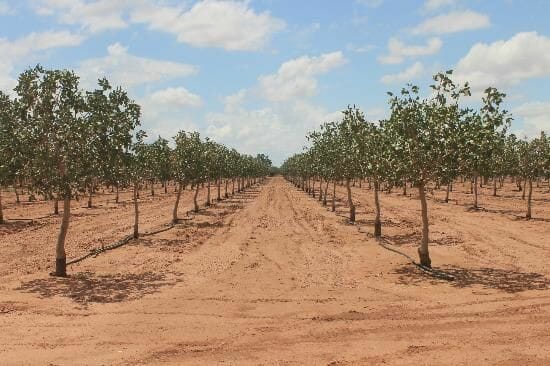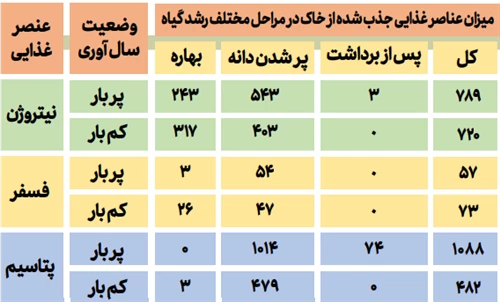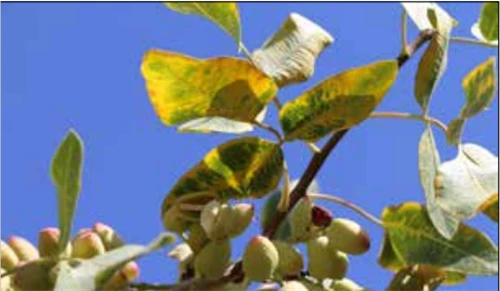
This year was favorable for pistachio cultivation in terms of climate, as there was neither frost damage nor poor rainfall. Early season rains prevented the outbreak of the psylla pest. However, some pistachio-growing areas faced weather-related challenges
This analysis is provided by Hossein Hokm Abadi, an expert who has been actively promoting pistachio cultivation in the Ministry of Agriculture Jihad. Over recent years, he has conducted numerous educational workshops for pistachio growers in various regions of the country. Given his extensive technical and educational visits to pistachio-growing areas throughout the year, we took the opportunity to ask him about the status of this year’s pistachio crop.
The Status of This Year’s Pistachio Crop
This year was a productive year for pistachios in Khorasan Razavi Province. However, early-season hailstorms caused the loss of about 50% of the pistachio crop, particularly in the cities of Bardaskan, Neyshabur, Torbat Heydariyeh, and Feyzabad, as well as parts of Bajestan and Gonabad. In some places, the hailstorms were so severe that they also affected next year’s crop. In Semnan Province, particularly in parts of Damghan, extremely heavy hail destroyed not only this year’s pistachio yield but also the leaves and fruits, affecting the next two years' crops.
In South and North Khorasan, there were no significant issues, and the pistachio yield in Birjand and Qaen was very good. In Tehran Province, Varamin and Pishva had an excellent harvest. Similarly, in Markazi Province, areas like Saveh, Zarandieh, and Peek had very productive years. In Buin Zahra, it was also a good year for pistachio production. In Qom Province, regions like Qomroud and the pistachio fields along Haj Khalil and Rahmatabad roads had abundant harvests.
In Isfahan Province, regions like Nain, Ardestan, and Abuzeydabad of Kashan, as well as Kashan itself, experienced excellent yields. In Yazd Province, Ardakan, Meybod, and Abarkuh had good pistachio production. In Kerman Province, Sirjan County had nearly excellent pistachio yields, and areas like Rafsanjan and Zarand also had relatively good production.
The Impact of Recent Heat on This Year’s Pistachio Crop
This summer, many regions experienced unusually high temperatures, the most severe heat in recent years. Meteorological data shows that areas like Buin Zahra, Qazvin, and Saveh reached temperatures of 45°C (113°F) in August, which they had never experienced before. In parts of Kerman and Yazd, temperatures soared to 48–49°C (118–120°F). This excessive heat, combined with power outages and water pump shutdowns for 5–6 hours, reduced both the quantity and quality of the pistachio crop, causing significant losses to growers.
Photosynthesis typically increases until temperatures reach 25°C (77°F) but declines beyond 27°C (81°F). At 39–40°C (102–104°F), photosynthesis essentially stops. This summer, even during sunrise and sunset, temperatures in most pistachio-growing regions exceeded 38–39°C, leaving many areas with no photosynthesis for several days.
As photosynthesis decreased, plant respiration increased above 30°C (86°F). Without photosynthesis, plants resorted to consuming their stored nutrients, leading to what growers describe as "kernel abortion." This phenomenon occurred wherever kernels were not fully developed before the intense heat. In areas where trees were behind schedule in growth due to the year’s conditions, the heat essentially halted the plants' internal processes.
Additionally, UV radiation levels were very high this summer, with indices reaching 9–10 on some days. Research indicates that UV indices of 11 or higher can cause reproductive issues, which likely impacted pistachio crops this year. The combination of reduced photosynthesis, increased respiration, and water stress due to irrigation delays is expected to result in both qualitative and quantitative losses.
What Can Be Done?
Given the current situation, growers are advised to take the following measures in the remaining time before harvest:
- Irrigation Management: Daily evaporation and transpiration rates are 4–6 mm, meaning trees need at least 1,300–1,400 cubic meters of water per hectare. Watering should prevent water stress.
- Use Cooling Agents: Apply materials like potassium silicate (2.5–3 per 1,000), kaolin (50 per 1,000), or similar compounds to reduce sunburn and block UV radiation.
- Limit Nitrogen Fertilizers: High temperatures reduce the effectiveness of nitrogen fertilizers and can lead to nitrogen toxicity and sunburn. Instead, potassium sulfate should be used to enhance the plant’s heat tolerance.
- Resume Fertilization After Cooling: When temperatures drop, photosynthesis will normalize, and kernel development will resume. In areas with controlled psylla infestation, applying urea (50–70 kg/ha) or liquid urea ammonium nitrate (UAN, 40–50 L/ha) can aid kernel filling.
- Harvest Timing: Harvest when 80% of the pistachio crop is ripe to minimize aflatoxin levels and maintain quality.

Post-Harvest Nutritional Recommendations
Recent studies show that pistachio trees absorb little nitrogen after harvest. Instead, growers should focus on calcium nitrate application during the first irrigation after harvest. For sensitive varieties like Akbari and Kaleh Ghouchi, 50 kg/ha is recommended; for others, 25 kg/ha suffices. After applying calcium, further irrigation should be stopped to allow the trees to enter dormancy.

Nutrient reserves in leaves should be depleted and stored in stems before winter. Applying potassium nitrate or potassium sulfate (4 per 1,000) with 0.5 per 1,000 fulvic acid helps this process. Fulvic acid enhances potassium absorption and nutrient mobility.
Research shows that post-harvest foliar sprays of fertilizers like Fruitest (calcium and boron) alongside potassium fertilizers improve bud quality for the next season. If spring applications are not feasible due to the risk of rain, fall applications are a suitable alternative.
In conclusion, careful irrigation, nutritional management, and timely harvesting are critical to mitigating the impacts of this year’s extreme heat on pistachio production.